Leroy C., Rancoita P.-G. Principles Of Radiation Interaction In Matter And Detection
Подождите немного. Документ загружается.


January 9, 2009 10:21 World Scientific Book - 9.75in x 6.5in ws-bo ok975x65˙n˙2nd˙Ed
360 Principles of Radiation Interaction in Matter and Detection
and 0.94 GeV/amu, respectively, and ii) for
11
B and heavier isotopes with energies
& 1 GeV/amu. In the same figure, the data indicated as “10 MeV proton equivalent”
correspond to the kinetic energies of isotopes calculated replacing the Lorentz factor
with that corresponding to 10 MeV proton in Eq. (4.114). As discussed at page 356,
up to these energies the NIEL deposition mechanism is expected to be dominated by
Coulomb interactions with a non-negligible contribution from strong interactions.
4.2.1.4 Electron Interactions
Electrons have a mass much lower than the recoil silicon atom. In an electron–silicon
elastic scattering for which 2γ (m
Si
/m
e
) ¿ (m
Si
/m
e
)
2
, where m
Si
and m
e
are the
silicon and electron rest masses and γ is the Lorentz factor of the incoming electron
of kinetic energy E
e
k
, the maximum transferred energy
†
, T
e
max
, is
T
e
max
' 20.02 τ (τ + 2) [eV], (4.115)
where τ = E
e
k
/m
e
, i.e., the kinetic energy of the electron in units of its rest mass. In
electron–silicon interactions, the kinetic energy below which T
e
max
is lower than
25 eV is about 255 keV.
It has been demonstrated
k
that the Mott–McKinley–Feshbach electron cross sec-
tion for a Coulomb collision with a point-like nucleus [McKinley and Feshbach
(1948); Seitz and Koehler (1956)] is accurate to one percent for nuclei with atomic
numb er up to 40 [Curr (1955)] and, for a nucleus initially at rest, is given by:
dσ(E
k
)
dE
Si
=
πr
2
e
Z
2
γ
2
β
4
"
1 − β
µ
β −
πZ
Si
137
¶
E
Si
T
e
max
−
πZ
Si
β
137
s
E
Si
T
e
max
#
T
e
max
E
2
Si
, (4.116)
where E
Si
is the kinetic energy of the recoil silicon nucleus and Z
Si
is its atomic
numb er; β, γ and r
2
e
are the velocity in units of c (i.e., the speed of light), the
Lorentz factor [Eq. (1.4)] and the classical radius of the electron, respectively. Using
Eq. (4.116), the expression (for E
Si
< T
e
max
)
P (E
Si
) =
Ã
Z
E
Si
E
d
dσ(E
k
)
dE
Si,r
dE
Si,r
!Ã
Z
T
max
E
d
dσ(E
k
)
dE
Si,r
dE
Si,r
!
−1
(4.117)
provides an estimate of the probability that the silicon recoils with a kinetic energy,
E
Si,r
, above the displacement threshold-energy (E
d
) and ≤ E
Si
. In Fig. 4.17, the
normalized integral of the electron cross section above the threshold energy for
displacement E
d
= 25 eV [i.e. P (E
Si
) calculated by means of Eq. (4.117)] is shown
as a function of the recoil silicon energy, E
Si
, in eV for incoming electrons with
kinetic energies of 1, 2, 5, 15, and 50 MeV.
†
It is calculated by means of Eq. (4.102), assuming that the silicon nucleus is at rest.
k
The reader can see [Cahn (1959)], Section 1 of Chapter 1 in [Vavilov and Ukhin (1977)] and
Section 2.2.4 in [van Lint, Flanahan, Leadon, Naber and Rogers (1980)].
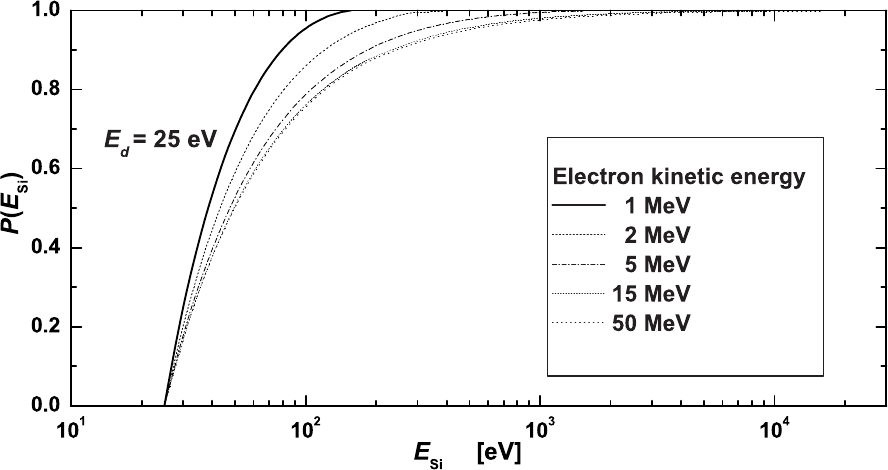
January 9, 2009 10:21 World Scientific Book - 9.75in x 6.5in ws-bo ok975x65˙n˙2nd˙Ed
Radiation Environments and Damage in Silicon Semiconductors 361
Fig. 4.17 P (E
Si
), normalized integral of the electron cross section calculated from Eq. (4.117), ab ove the threshold energy for displacement E
d
= 25
eV, as a function of the recoil silicon energy E
Si
in eV (from [Leroy and Rancoita (2007)]).

January 9, 2009 10:21 World Scientific Book - 9.75in x 6.5in ws-bo ok975x65˙n˙2nd˙Ed
362 Principles of Radiation Interaction in Matter and Detection
In the modified Kinchin–Pease formula
∗∗
the average number of displacements,
< N
F P
> (including the one resulting from the initial knock-on), due to a PKA
with damage energy E
de
is 1 for E
d
< E
de
< 2.5E
d
and < N
F P
>= E
de
/(2.5E
d
)
for E
de
> 2.5E
d
. In electron–silicon interactions since the recoil energy is usually
small (e.g., E
Si
is lower than about few keV), E
de
is about (80–90) % of E
Si
(see
Fig. 4.15). Furthermore from Eq. (4.115), silicon cascading-displacements may be-
come relevant only for electrons with kinetic energies larger than about 5 MeV. As
the electron energy decreases (e.g., see the curve for 1 MeV in Fig. 4.17), the pro-
bability for a single silicon displacement increases.
4.2.1.5 Damage Function
The evaluation
‡‡
of the damage function in silicon, i.e., of the non-ionization energy-
loss, has been primarily based on experimental data. Furthermore a series of calcu-
lations
∗
, involving the various types of interactions (e.g., see [Ougouag, Williams,
Danjaji, Yang and Meason (1990)]), for neutron kinetic energies 10
−10
≤ E
n
k
≤
2.4 ×10
4
MeV has been also performed . In Fig. 4.18 the damage function (in units
of MeV mb) for neutrons is shown including i) the HGK compilation [Vasilescu and
Lindstroem (2000)] for 10
−9
< E
n
k
< 10
4
MeV and E
d
= 25 eV, ii) the calculation
of Van Ginneken (1989) for 10 < E
n
k
< 10
3
MeV and E
d
= 25 eV and, finally, iii)
the calculation of Huhtinen (2002) for 20 < E
n
k
< 10
4
MeV and E
d
= 20 eV. In the
energy range up to 20 MeV, Ougouag [Ougouag, Williams, Danjaji, Yang and Mea-
son (1990)] and Griffin [Vasilescu and Lindstroem (2000)] calculations are almost
equivalent and were computed for a displacement energy E
d
= 25 eV. However (see
Fig. 4.19), in the energy region 15 < E
n
k
< (18–20) MeV these latter damage func-
tions [Van Ginneken (1989)] are larger than the one computed by Van Ginneken
with E
d
= 25 eV which, in turn, agrees (for E
n
k
up to about 200 MeV) with that
recently computed by Huhtinen (2002) with E
d
= 20 eV (Figs. 4.18 and 4.19). For
15 < E
n
k
< 200 MeV, the damage functions computed by Van Ginneken (1989)
and Huhtinen (2002) are lower than that of Konobeyev [Vasilescu and Lindstroem
(2000)] (Figs. 4.18 and 4.19). For 10
−3
< E
n
k
< 15 MeV, the calculations of Griffin
[Vasilescu and Lindstroem (2000)] and Huhtinen (2002) differ slightly: the diffe-
rent values of the displacement energy can (partially) account for such a difference
(e.g., see the discussion in [Huhtinen (2002)]). The damage functions estimated
in [Vasilescu and Lindstroem (2000); Huhtinen (2002)] for E
d
= 25 and 20 eV differ
slightly in the energy region 1.5 < E
n
k
< 5 GeV. As pointed out by Huhtinen (2002),
∗∗
It is given by Eq. (4.89) and see, for instance, [Norgett, Robinson and Torrens (1975)], Chapter 4
in [Ziegler, Biersack and Littmark (1985a)], [Messenger et al. (1999)] and, also, [Kinchin and Pease
(1955)].
‡‡
One can see, e.g., [Smith, Binder, Compton and Wilbur (1966); Conrad (1971); Namenson,
Wolicki and Messenger (1982); Summers et al. (1987); Cheryl, Marshall, Burke, Summers and
Wolicki (1988); Summers, Burke, Shapiro, Messenger and Walters (1993)] and references therein.
∗
The reader can see, for instance, [Van Ginneken (1989); Ougouag, Williams, Danjaji, Yang and
Meason (1990); Vasilescu and Lindstroem (2000); Huhtinen (2002)] and references therein.

January 9, 2009 10:21 World Scientific Book - 9.75in x 6.5in ws-bo ok975x65˙n˙2nd˙Ed
Radiation Environments and Damage in Silicon Semiconductors 363
experimental data are needed to determine which of the computed damage functions
is more correct for high-energy neutrons.
The damage function for protons has been computed for 10
−4
. E
p
k
.
2.4 × 10
4
MeV with 12.9 ≤ E
d
≤ 25 eV and compared with experimental data by
many authors (e.g., [Summers et al. (1987); Van Ginneken (1989); Summers, Burke,
Shapiro, Messenger and Walters (1993); Vasilescu and Lindstroem (2000); Akker-
man, Barak, Chadwick, Levinson, Murat and Lifshitz (2001); Huhtinen (2002);
Messenger, Burke, Summers and Walters (2002); Jun et al. (2003)]). For protons
with kinetic energies above 10 MeV, the damage function was found to be slightly de-
pendent on E
d
(see for instance [Summers, Burke, Shapiro, Messenger and Walters
(1993)]). Jun et al. (2003) have revised previous calculations up to 200 MeV [Sum-
mers, Burke, Shapiro, Messenger and Walters (1993); Akkerman, Barak, Chadwick,
Levinson, Murat and Lifshitz (2001)] and extended the proton kinetic energy range
up to 1 GeV. These authors have successfully used the Ziegler–Biersack–Littmark
(ZBL) screened Coulomb potential [Ziegler, Biersack and Littmark (1985a); Ziegler,
J.F. and M.D. and Biersack (2008a)] coupled to the relativistic energy transfer cross
section at higher incident energies. In addition, they have employed a charged par-
ticle transport code (MCNPX, based on the thin target approximation) to compute
the nuclear contribution to non-ionizing energy-loss for protons which accounts for
about 15 % (50 %) at 10 (20) MeV (e.g., see [Jun et al. (2003)] and references therein
for details of the treatment). The MCNPX code [MCNPX (2006)] uses the cross
sections from Barashenkov and Polanski (1994) to determine the probability of ela-
stic and non-elastic interactions. For non-elastic reactions, the kinetic energy of the
PKA is computed based on the concept of high-energy intra-nuclear cascade, pre-
equilibrium and evaporation physics. In Fig. 4.20, the latest calculations for protons
are shown in the kinetic energy ranges i) 2×10
−4
≤ E
p
k
≤ 10
3
MeV with E
d
= 21 eV
[Jun et al. (2003)], ii) 10
3
≤ E
p
k
≤ 2.4×10
4
MeV with E
d
= 20 eV [Huhtinen (2002)]
and, finally, iii) 15 ≤ E
p
k
≤ 9×10
3
MeV with E
d
= 20 eV [Vasilescu and Lindstroem
(2000)]. Furthermore, Huhtinen has also computed the damage function for pions
(e.g., see [Huhtinen (2002)] and references therein). In silicon, the damage function
for heavy-ions, with a kinetic energy range of 10
−4
< E
tot
k
< 10
3
MeV and displa-
cement threshold energy E
d
= 21 eV, was calculated using interatomic screened
Coulomb potentials (expressed in the form of the ZBL universal potential [Ziegler,
Biersack and Littmark (1985a); Ziegler, J.F. and M.D. and Biersack (2008a)]) in the
non-relativistic limit by Messenger et al. (2003) and (2004). These calculations are
relevant for space missions where spacecrafts and pay-loads are exposed to energetic
GCRs in addition to the trapped particles (mostly electrons and protons) popula-
ting the radiation belts (Sect. 4.1.2.5). In Fig. 4.21, the damage functions for iron,
silicon, boron ions and α-particles (i.e., heavy ions with Z ≤ 28) are shown as a
function of the ion kinetic energy in MeV. However, in order to evaluate properly the
displacement damage, they must be extended to about
∗∗
1 GeV/nucleon (e.g., for
∗∗
The reader can find the definition of kinetic energies per nucleon in Sect. 1.4.1.
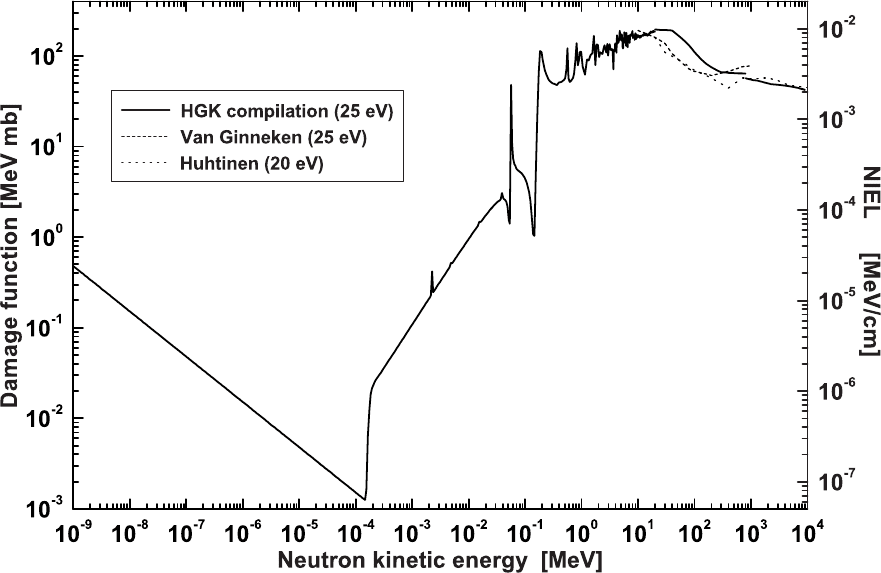
January 9, 2009 10:21 World Scientific Book - 9.75in x 6.5in ws-bo ok975x65˙n˙2nd˙Ed
364 Principles of Radiation Interaction in Matter and Detection
Fig. 4.18 Damage function for neutrons with kinetic energies of 10
−9
≤ E
n
k
≤ 10
4
MeV (adapted from [Leroy and Rancoita (2007)]). For Van
Ginneken (1989) and HGK compilation [Vasilescu and Lindstroem (2000)], the displacement energy is E
d
= 25 eV; for Huhtinen (2002), E
d
=
20 eV. The tabulated data are shown interpolated by spline lines.
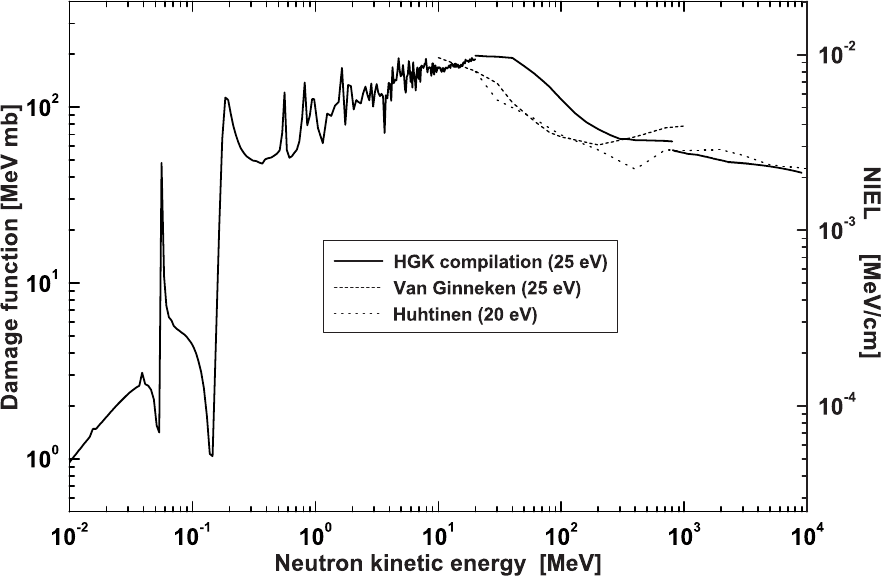
January 9, 2009 10:21 World Scientific Book - 9.75in x 6.5in ws-bo ok975x65˙n˙2nd˙Ed
Radiation Environments and Damage in Silicon Semiconductors 365
Fig. 4.19 Expanded view of Fig. 4.18: damage function for neutrons with kinetic energies of 10
−2
≤ E
n
k
≤ 10
4
MeV (adapted from [Leroy and
Rancoita (2007)]). For Van Ginneken (1989) and HGK compilation [Vasilescu and Lindstroem (2000)], the displacement energy is E
d
= 25 eV; for
Huhtinen (2002), E
d
= 20 eV. The tabulated data are shown interpolated by spline lines.
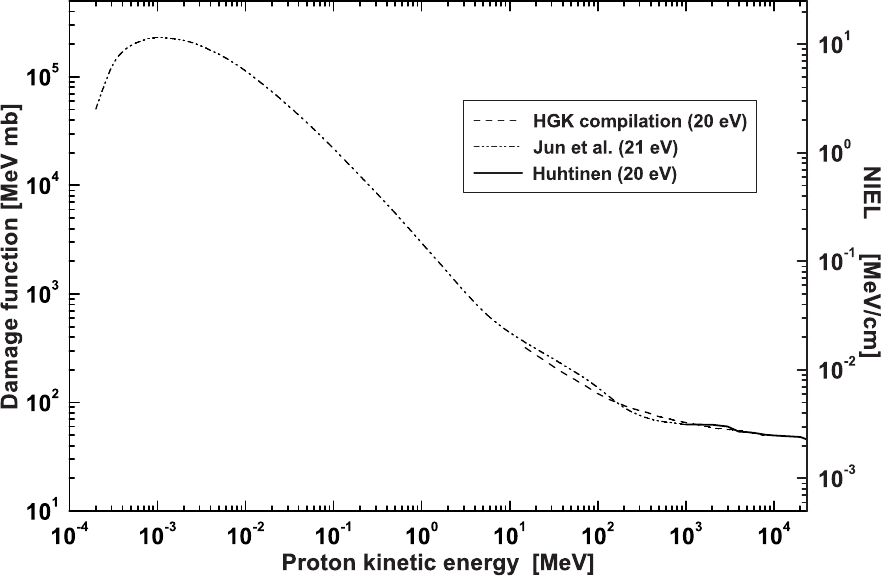
January 9, 2009 10:21 World Scientific Book - 9.75in x 6.5in ws-bo ok975x65˙n˙2nd˙Ed
366 Principles of Radiation Interaction in Matter and Detection
Fig. 4.20 Damage function for protons (adapted from [Leroy and Rancoita (2007)]). The proton kinetic energy range is 2 × 10
−4
≤ E
p
k
≤
2.4 × 10
4
MeV. For Jun et al. (2003) E
d
= 21 eV; for Huhtinen (2002) and HGK compilation [Vasilescu and Lindstroem (2000)] E
d
= 20 eV. The
tabulated data are shown interpolated by spline lines.
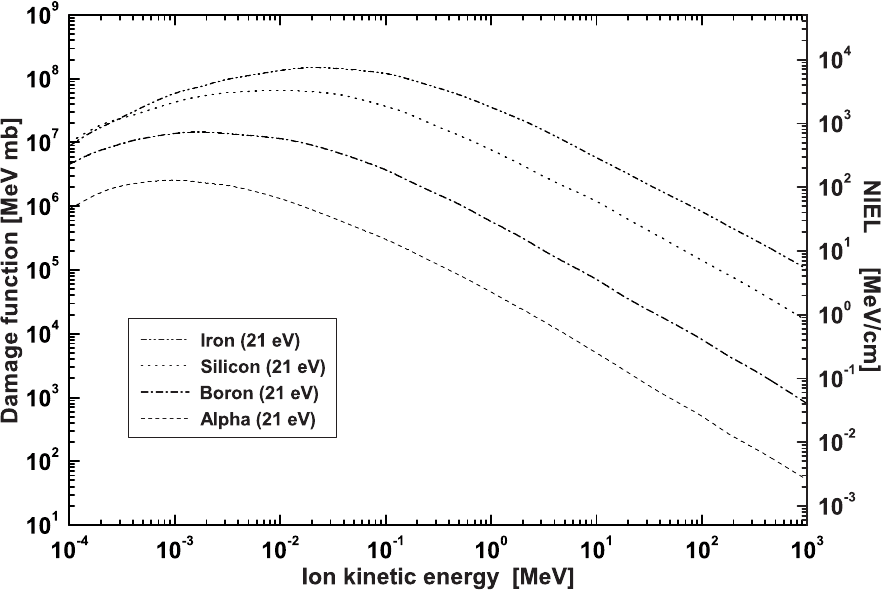
January 9, 2009 10:21 World Scientific Book - 9.75in x 6.5in ws-bo ok975x65˙n˙2nd˙Ed
Radiation Environments and Damage in Silicon Semiconductors 367
Fig. 4.21 Damage functions in silicon (adapted from [Leroy and Rancoita (2007)]) for iron, boron, silicon ions and α-particles with a kinetic energy
range of 10
−4
≤ E
tot
k
≤ 10
3
MeV and E
d
= 21 eV [Messenger et al. (2003, 2004)]. The data are shown interpolated by spline lines.
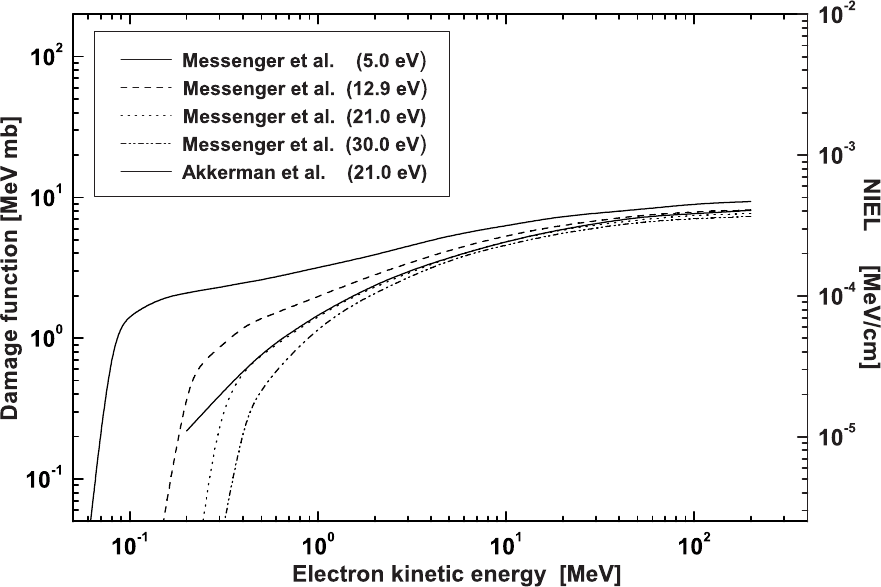
January 9, 2009 10:21 World Scientific Book - 9.75in x 6.5in ws-bo ok975x65˙n˙2nd˙Ed
368 Principles of Radiation Interaction in Matter and Detection
Fig. 4.22 Damage function for electrons with a kinetic energy range of 0.6 . E
e
k
≤ 200 MeV (adapted from [Leroy and Rancoita (2007)]): for
E
d
= 5, 12.9, 21 and 30 eV from [Messenger et al. (1999)] and E
d
= 21 eV from [Akkerman, Barak, Chadwick, Levinson, Murat and Lifshitz
(2001)]. The tabulated data are shown interpolated by spline lines.

January 9, 2009 10:21 World Scientific Book - 9.75in x 6.5in ws-bo ok975x65˙n˙2nd˙Ed
Radiation Environments and Damage in Silicon Semiconductors 369
α-particles see Fig. 4.12) and account for strong interactions (see Sect. 4.2.1.3).
Although the damage functions have been computed with different values of
E
d
, the displacement threshold energy seems not to be the major source of un-
certainty. Only for low energy electrons (e.g., < 2 MeV) and, as a consequence,
60
Co γ-ray radioactive-sources, E
d
is relevant to estimate the overall non-ionizing
energy-loss deposition and concentration of induced displacement damages.
The latest calculations of the damage function for electrons
††
have taken into
account displacement energies from 5 to 30 eV
‡‡
. Above a few hundred MeV, the
non-ionizing energy-loss is almost independent of the energy of the incoming particle
[Van Ginneken (1989)]. However, a slight energy dependence is found in the electron
kinetic energy range 50 < E
e
k
< 200 MeV [Van Ginneken (1989); Summers, Burke,
Shapiro, Messenger and Walters (1993); Messenger et al. (1999); Akkerman, Barak,
Chadwick, Levinson, Murat and Lifshitz (2001)]. In Fig. 4.22, the damage functions
for electrons computed by Messenger et al. (1999) and Akkerman, Barak, Chadwick,
Levinson, Murat and Lifshitz (2001) with electron kinetic energies in the range 0.6 <
E
e
k
< 200 MeV are shown: ab ove ≈ 300 keV, the calculations for E
d
= 21 eV are
in good agreement. In addition, Messenger et al. (1999) have shown (see Fig. 4.22)
that the damage function for E
d
= 21 and 30 eV does not differ by more than about
2.7 % at 5 MeV and 0.9 % above 10 MeV.
60
Co γ-ray radioactive-sources are widely used in space qualification procedures
and to study radiation-induced damage in silicon devices. In silicon, Compton
scattering is the main interaction process of the emitted γ-rays with energies of
1.1732 and 1.3325 MeV (e.g., see Appendix A.8). The secondary electrons have,
usually, enough kinetic energy to displace silicon atoms. Thus, combining the energy
spectrum of the slowed-down secondary electrons with the electron damage func-
tion (e.g., that given in Fig. 4.22) the damage function for the
60
Co γ-ray source
can be obtained
†
and sometimes expressed in terms of 1 MeV electron-equivalent
displacement-damage (e.g., see [Xapsos et al. (1994)]). In addition, the introduction
of a shielding material in front of the silicon device can affect the resulting elec-
tron spectrum
¶
and, as a consequence, the damage energy deposited. Furthermore,
from an inspection of the energy distribution of the scattered Compton electron
(e.g., see Fig. 2.55 and Figure 2.16 in [van Lint, Flanahan, Leadon, Naber and
††
The reader can also find NIEL calculations by means of the NEMO code ([Inguimbert and
Gigante (2006)] and references therein); they are in agreement with those in [Summers, Burke,
Shapiro, Messenger and Walters (1993)] above a few MeV of kinetic energy.
‡‡
The reader may see [Summers, Burke, Shapiro, Messenger and Walters (1993)] for E
d
= 12.9
and 21 eV, [Van Ginneken (1989)] for E
d
= 25 eV, [Akkerman, Barak, Chadwick, Levinson, Murat
and Lifshitz (2001)] for E
d
= 21 eV and, finally, [Messenger et al. (1999)] for E
d
= 5, 12.9, 21 and
30 eV.
†
One can see, for instance, [Summers, Burke, Shapiro, Messenger and Walters (1993)]; also
[Xapsos et al. (1994); Akkerman, Barak, Chadwick, Levinson, Murat and Lifshitz (2001)] for
E
d
= 21 eV and references therein.
¶
Calculations for shielding thicknesses ranging from 100 µm up to 2 mm are shown in [Akkerman,
Barak, Chadwick, Levinson, Murat and Lifshitz (2001)].
